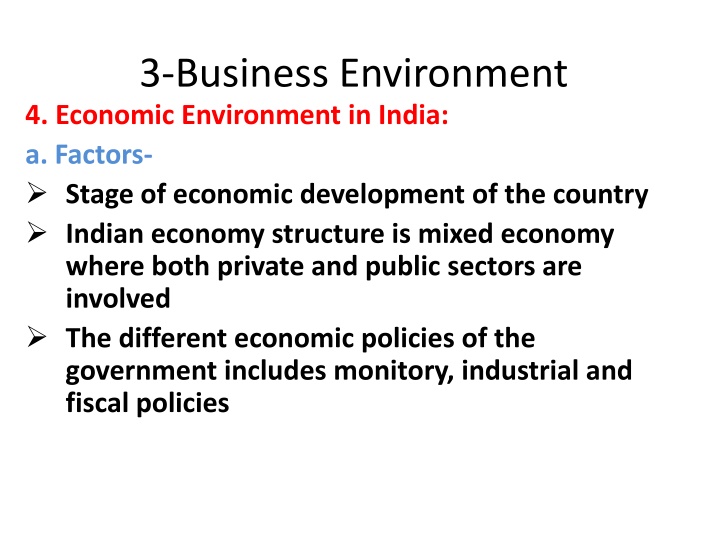
Economic Environment in India: Factors, Transition & Policies
Explore the economic environment in India, covering factors influencing economic development, the transition of the Indian economy, and pivotal policies like liberalization, privatization, and globalization. Learn about the mixed economy structure, economic planning, and the New Economic Policy of 1991.
Download Presentation

Please find below an Image/Link to download the presentation.
The content on the website is provided AS IS for your information and personal use only. It may not be sold, licensed, or shared on other websites without obtaining consent from the author. If you encounter any issues during the download, it is possible that the publisher has removed the file from their server.
You are allowed to download the files provided on this website for personal or commercial use, subject to the condition that they are used lawfully. All files are the property of their respective owners.
The content on the website is provided AS IS for your information and personal use only. It may not be sold, licensed, or shared on other websites without obtaining consent from the author.
E N D
Presentation Transcript
3-Business Environment 4. Economic Environment in India: a. Factors- Stage of economic development of the country Indian economy structure is mixed economy where both private and public sectors are involved The different economic policies of the government includes monitory, industrial and fiscal policies
3-Business Environment 4. Economic Environment in India: a. Factors- Economic planning including five year plans, annual budgets etc Economic indices like national income, distribution of income, per capita income etc Infrastructural factors such as financial institutions, banks, modes of transportation, communication facilities etc.
3-Business Environment 4. Economic Environment in India: b. Process of Transition of Indian Economy The constituents of economic environment of biz in India at the time of independence Primarily an agrarian Indian economy and rural in nature More than 70% population engaged in agriculture Use of backward method of production Poor public health facilities Key aspects of the economic planning in India after independence Implementation of New Industrial Policy 1991 To become self reliant To reduce inequalities of income and wealth To set up a socialist pattern in society Liberalisation Privatisation Globalisation
3-Business Environment 4. Economic Environment in India: c. New Economic Policy 1991-on July 24, 1991, GOI announced policy with an aim to correct weakness of the Industrial structure. Features of New Economic Policy, 1991 Liberate the Indian industries from licensing system- Liberalisation To reduce the role of public sector in the economy- Privatisation To promote foreign private participation in industrial development of the country- Globalisation
3-Business Environment 4. Economic Environment in India: d. Liberalisation, Privatisation, Globalisation Liberalisation Privatisation Globalisation End the license permit and free the industry from unnecessary controls and restrictions Give greater role to the private sector and reduce the role to the public sector Integration of various economies of the world leading towards the emergence of global economy GOVERNMENT INITIATIVES GOVERNMENT INITIATIVES GOVERNMENT INITIATIVES Adopted disinvestment in public sector Refer the loss and sick units to BIFR Import liberalisation and export promotion Increased level of interaction with countries Abolishing License requirement Freedom in deciding scale of biz. activities
3-Business Environment 4. Economic Environment in India: d. Liberalisation, Privatisation, Globalisation Liberalisation Privatisation Globalisation GOVERNMENT INITIATIVES GOVERNMENT INITIATIVES GOVERNMENT INITIATIVES Removal of restrictions on the movement of goods and services Freedom in fixing the price of goods and services Reduction in tax rates Simplifying export and import procedures Attract foreign capital and technology to India
Managerial Response to changes in BE Changes in capital structure Acquisitions and mergers Customer oriented approach Diversification Technological developments Brand building Innovative distribution and selling technique Managerial Response Better labour relations
Demonetisation Demonetisation refers to the act of scrapping a currency unit of its status as legal tender Three times in 1946, 1978 and on 8thNov, 2016 86% of the currency in circulation ceased as legal tender Old notes were deposited in the banks for new notes The issuance of new 500 and 2000 banknotes in exchange for demonetised currency was announced
Demonetisation Objectives: To curb corruption To curtail circulation of counterfeit notes To restrain funding of illegal activities such as terrorism and drug trafficking To contain accumulation of black money
Demonetisation Implications: It is an expensive process as government has to incur huge cost in the process It affected the trade and consumption in the economy as the biz was heavily dependent on cash for monetary transactions Brought radical change in the economy by shifting focus of people towards cash less transactions Digitilisation divided society in to three sections- poor people who do not own cellphones, less affluent people who are becoming part of digital economy and affluent people who own smartphones.
Demonetisation Features: Tax administration measure: People with accumulated black money had to deposit cash in the bank and pay taxes at penalty rate. Stringent approach towards tax evasion: Government communicated that the practice of tax evasion will neither tolerated Channelising savings into the formal financial system: Cash holdings will be deposited in the bank, banks will decrease interest rates, investors will shift towards non deposit such as shares and mutual funds for higher returns. Development of cashless economy: This will help the tax evaders to pay taxes and promote chanelising of savings into formal financial system
Impact of Govt. policy changes on biz. And industry/challenges faced by the Indian Corporate Sector 1. Increasing Competition: Changes in the rules of industrial licensing have paved way for the entry of foreign firms into the country. This has increased the level of competition within the economy for the Indian firm Competition has increased in the service industries like banking, insurance, telecommunications, aviation as these industries were earlier reserved for public sector only.
Impact of Govt. policy changes on biz. And industry/challenges faced by the Indian Corporate Sector 2. More demanding customers: Education has increased the level of awareness and expectations of consumers. Due to high competition, business offers wider choices of products at good quality and competitive prices.
Impact of Govt. policy changes on biz. And industry/challenges faced by the Indian Corporate Sector 3. Rapidly changing technological environment: The tough competition has forced the business firms to focus on innovative technologies for survival and growth. Better technology improves the efficiency of the machines, processes, products and services.
Impact of Govt. policy changes on biz. And industry/challenges faced by the Indian Corporate Sector 4. Necessity for change: The new economic policy of 1991 has made the business dynamic in nature. As a consequence, the business firms have to constantly strive to realise their objectives in the dynamic environment by constantly reviewing and revising their plans.
Impact of Govt. policy changes on biz. And industry/challenges faced by the Indian Corporate Sector 5. Need for developing human resource: No business can prosper in the absence of efficient and effective human resource. As a result, of implementation of new economic policy the needs of the business enterprises changed significantly in terms of the requirements of manpower. In order to thrive in the dynamic business environment, a business needs more competent and committed human resource who is able to constantly innovate new ways of adapting and operating.
Impact of Govt. policy changes on biz. And industry/challenges faced by the Indian Corporate Sector 6. Market orientation: The implementation of new economic policy has shifted the approach of the marketers from seller oriented to consumer oriented. A customer oriented approach emphasises on the needs of the prospective buyers. It is necessary to study and analyse the needs of the market and produce goods accordingly.






















